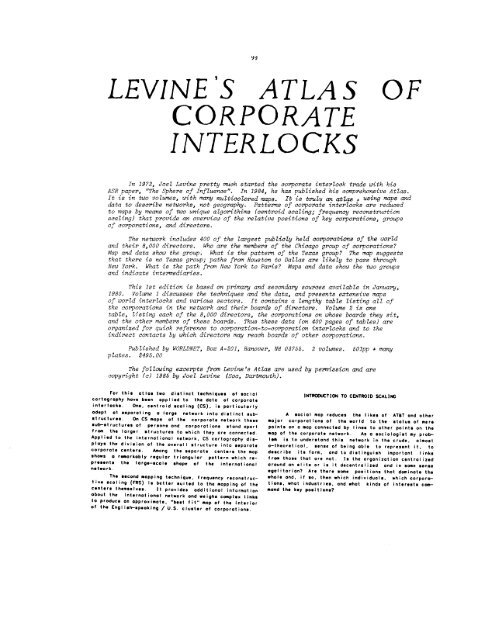(1985). Levine's Atlas of Corporate Interlocks. Connections ... - INSNA
(1985). Levine's Atlas of Corporate Interlocks. Connections ... - INSNA
(1985). Levine's Atlas of Corporate Interlocks. Connections ... - INSNA
Create successful ePaper yourself
Turn your PDF publications into a flip-book with our unique Google optimized e-Paper software.
9 9<br />
LEVINE'S ATLAS OF<br />
CORPORATE<br />
INTERLOCKS<br />
In 1972, Joel Levine pretty much started the corporate interlock trade with his<br />
ASR paper, "The Sphere <strong>of</strong> Influence" . In 1984, he has published his comprehensive <strong>Atlas</strong> .<br />
It is in two volumes, with many multicolored maps . It is truly an atlas , using maps and<br />
data to describe networks, not geography . Patterns <strong>of</strong> corporate interlocks are reduced<br />
to maps by means <strong>of</strong> two unique algorithims (centroid scaling ; frequency reconstruction<br />
scaling) that provide an overview <strong>of</strong> the relative positions <strong>of</strong> key corporations, groups<br />
<strong>of</strong> corporations, and directors .<br />
The network includes 400 <strong>of</strong> the largest publicly held corporations <strong>of</strong> the world<br />
and their 8,000 directors . Who are the members <strong>of</strong> the Chicago group <strong>of</strong> corporations<br />
Map and data show the group . What is the pattern <strong>of</strong> the Texas group The map suggests<br />
that there is no Texas group; paths from Houston to Dallas are likely to pass through<br />
New York . What is the path from New York to Paris Maps and data show the two groups<br />
and indicate intermediaries .<br />
This 1st edition is based on primary and secondary sources available in January,<br />
1980 . Volume 1 discusses the techniques and the data, and presents extensive maps<br />
<strong>of</strong> world interlocks and various sectors . It contains a lengthy table listing all <strong>of</strong><br />
the corporations in the network and their boards <strong>of</strong> directors . Volume 2 is one<br />
table, listing each <strong>of</strong> the 8,000 directors, the corporations on whose boards they sit,<br />
and the other members <strong>of</strong> these boards . Thus these data (on 400 pages <strong>of</strong> tables) are<br />
organized for quick reference to corporation-to-corporation interlocks and to the<br />
indirect contacts by which directors may reach boards <strong>of</strong> other corporations .<br />
Published by WORLDNET, Box A-201, Hanover, NH 03755 . 2 volumes . 501pp + many<br />
plates . $495 .00<br />
The following excerpts from <strong>Levine's</strong> <strong>Atlas</strong> are used by permission and are<br />
copyright (c) <strong>1985</strong> by Joel Levine (Soc, Dartmouth) .<br />
For this atlas two distinct techniques <strong>of</strong> social<br />
cartography hove been applied to the data <strong>of</strong> corporate<br />
interlocks . One, centroid scaling (CS) . is particularly<br />
adept at separating a large network into distinct substructures<br />
. On CS maps <strong>of</strong> the corporate network these<br />
sub-structures <strong>of</strong> persons and corporations stand apart<br />
from the larger structures to which they ore connected .<br />
Applied to the international network . CS cartography disploys<br />
the division <strong>of</strong> the overall structure into separate<br />
corporate centers . Among the separate centers the mop<br />
shows a remarkably regular triangular pattern which represents<br />
the large-scale shape <strong>of</strong> the international<br />
network .<br />
The second mapping technique, frequency reconstructive<br />
scaling (FRS) is better suited to the mopping <strong>of</strong> the<br />
centers themselves . It provides additional information<br />
about the International network and weighs complex links<br />
to produce an approximate, "best fit" mop <strong>of</strong> the interior<br />
<strong>of</strong> the English-speaking / U .S . cluster <strong>of</strong> corporations .<br />
INTRODUCTION TO CENTROID SCALING<br />
A social mop reduces the likes <strong>of</strong> AT&T and other<br />
major corporations <strong>of</strong> the world to the status <strong>of</strong> mere<br />
points on a mop connected by lines to other points on the<br />
mop <strong>of</strong> the corporate network . As a sociologist my problem<br />
is to understand this network in the crude, almost<br />
o-theoretical, sense <strong>of</strong> being able to represent it, to<br />
describe its form, and to distinguish important links<br />
from those that ore not . Is the organization centralized<br />
around on elite or is it decentralized and in some sense<br />
egalitarian Are there some positions that dominate the<br />
whole and, if so, then which individuals, which corporations,<br />
what industries, and what kinds <strong>of</strong> interests command<br />
the key positions

















